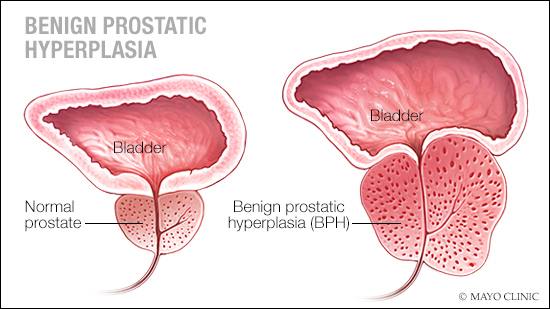-
Featured News
Mayo Clinic Q and A: New steam treatment for benign prostatic hyperplasia
 DEAR MAYO CLINIC: I was diagnosed with benign prostatic hyperplasia four years ago. It didn’t bother me at first, so my health care provider recommended watchful waiting. But now it’s causing quite a few problems, and we’re talking about surgery. I heard there’s a new treatment for benign prostatic hyperplasia that involves steam. Does it work? Are there side effects?
DEAR MAYO CLINIC: I was diagnosed with benign prostatic hyperplasia four years ago. It didn’t bother me at first, so my health care provider recommended watchful waiting. But now it’s causing quite a few problems, and we’re talking about surgery. I heard there’s a new treatment for benign prostatic hyperplasia that involves steam. Does it work? Are there side effects?
ANSWER: There are several procedures available to treat benign prostatic hyperplasia, or BPH, including a relatively new treatment that uses steam to reduce the size of the prostate and ease symptoms. This treatment has been shown to effectively eliminate excess prostate tissue, while carrying a low risk of side effects.
Benign prostatic hyperplasia is enlargement of the prostate gland that’s not related to cancer. It’s a common condition in men as they age. The prostate gland is beneath the bladder. The tube that transports urine from the bladder, called the urethra, passes through the center of the prostate. When it first starts, benign prostatic hyperplasia may cause few, if any, symptoms. But, as the prostate grows larger over time, it can block urine flow through the urethra, and that can cause problems.
Common benign prostatic hyperplasia symptoms include a frequent or urgent need to urinate, difficulty starting urination, weak urine stream, a stream that stops and starts, increased urination at night or inability to completely empty the bladder.
Treatment for benign prostatic hyperplasia focuses on managing symptoms, so delaying treatment until symptoms appear, as in your situation, is common. Medication can be effective for mild to moderate benign prostatic hyperplasia. If symptoms become severe, or if medication is not enough to manage your symptoms, then a surgical procedure may be recommended.
A variety of procedures can treat benign prostatic hyperplasia. Most involve removing or destroying excess prostate tissue. Examples include procedures that use lasers or an electric loop, which burn the prostate from the inside out. Now, a convective water therapy treatment that uses steam to make the prostate smaller also is available.
Steam treatment for benign prostatic hyperplasia is performed in a health care provider’s office, and the procedure itself usually takes less than 15 minutes. It doesn’t require a hospital stay. During the treatment, a tiny needle is inserted into the urethra and positioned within the prostate gland. In nine seconds, the needle produces a steam ball within the prostate that is about 2 centimeters wide. All the tissue the steam touches is destroyed. That eliminates the extra prostate tissue that causes benign prostatic hyperplasia symptoms.
Possible side effects from prostate treatment depend on the type of procedure that’s used. In general, complications from traditional therapy can include urinary tract infection, bleeding, semen flowing backward into the bladder instead of out through the penis during ejaculation, erectile dysfunction, and, rarely, loss of bladder control and prostate regrowth over time.
Many of these side effects happen because treatment damages the nerves that surround the prostate gland. With steam treatment, the risk of these complications is low because the heat from the treatment doesn’t reach the nerves, so they remain unaffected. A risk of infection still exists. For a period of time after the procedure is done, problems with urination may get worse temporarily. But, in most cases, that side effect does not last.
Steam treatment is relatively new, so long-term data regarding its success rate it not yet available. But, in the three years it has been widely available, studies show that in 90 to 95 percent of men who have steam treatment, benign prostatic hyperplasia symptoms are significantly reduced or eliminated. — Dr. Tobias Kohler, Urology, Mayo Clinic, Rochester, Minnesota
Learn more about BPH (benign prostatic hyperplasia) services







